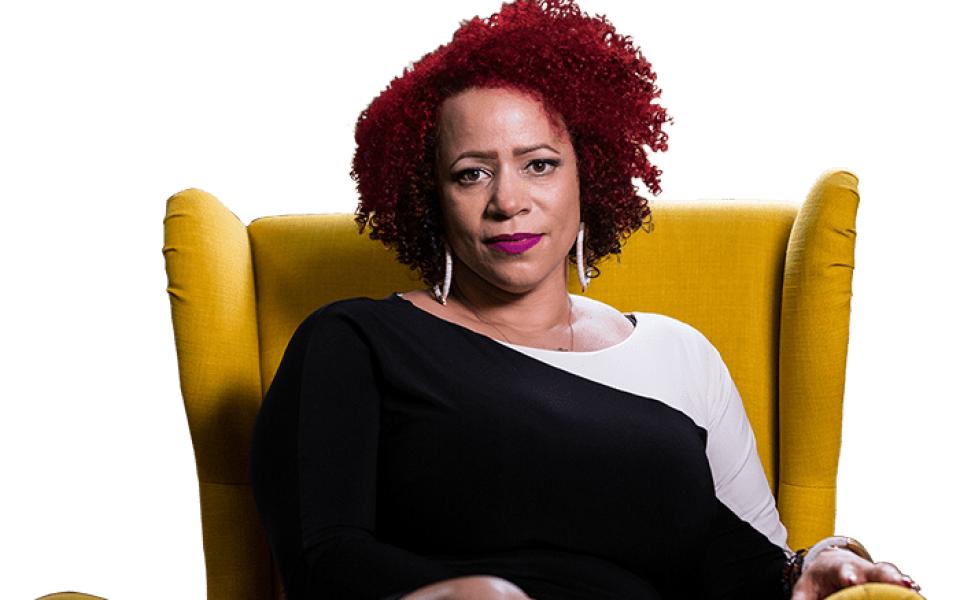A black and white photo of white mothers carrying a casket with a black baby doll projects onto the screen. A moment later, the screen switches to an image of six-year-old Ruby Bridges making her way down a set of steps — escorted by US Marshals — clutching a tiny briefcase in her right hand.
“These photos are black and white, but this wasn’t that long ago,” said Nikole Hannah-Jones, staff writer for the New York Times and MacArthur “Genius Grant” winner. Another photo of federal troops escorting black students through a white mob appears.
“This was violently resistant,” she said. “These people are arguing about children getting an education.”
Hannah-Jones gave a stirring presentation in the Kenneth R. Williams Auditorium on Winston-Salem State University’s campus on Thursday evening, speaking for more than an hour about the inequality and racial segregation in the American public school system.
“I don’t give inspirational speeches,” Hannah-Jones said at the start of her talk. “If you don’t feel discomfort at the end of my speech, I feel like I’ve failed.”
Hannah-Jones has been writing and reporting on education for the last 15 years. She got her start at Chapel Hill News and the News and Observer after graduating with a masters in journalism from UNC-Chapel Hill in 2003. From there, the journalist went on to work for The Oregonian, ProPublica and now the New York Times. In August, she launched the 1619 Project, a major initiative examining the legacy of slavery in the United States timed for the 400th anniversary of the arrival of the first enslaved people to the country.
“All I ever wanted to write about was racial inequality,” Hannah-Jones said in a phone interview on Friday. “So, when I started covering Durham Public Schools it was perfect because it was very segregated. There was no way to write about it and not talk about racial inequality.”
Displaying a timeline of racist policies from the start of slavery through Jim Crow and beyond on the screen, Hannah-Jones broke down how systemic injustice takes place within public education, detrimentally affecting black and brown students.
She explained how for centuries, black Americans were barred from being educated by having resources and access to schooling withheld from them. Even after the Supreme Court Ruling of Brown v. Board of Education in 1954 finding that racial segregation of children in public schools was unconstitutional, subsequent court rulings and public policy just a few decades later re-segregated much of the country back to how it was during the Jim Crow era, Hannah-Jones said.
“Separate is inherently unequal,” Hannah-Jones said in her speech. “The longer a child stays in a segregated school, the more the achievement gap increases.”
Speaking to an auditorium full of educators, school board members, parents and concerned community members, Hannah-Jones pivoted halfway through her presentation to the state of Winston-Salem/Forsyth County Schools.
“This is one of the most segregated districts in the state,” she said.
A 2018 report titled “Stymied by Segregation” by Kris Nordstrom, a policy analyst with the NC Justice Center, backed Hannah-Jones’s claim.
Nordstrom’s report found that the Forsyth County school district was among the top ten most segregated district by race and economics.
Using an interactive tool called Miseducation by ProPublica during her presentation, Hannah-Jones compared two high schools in the district: Carver High School and Ronald W. Reagan High School. The first has a predominantly black student population, with black students making up 71 percent of the school, while the latter is 73 percent white.
Hannah-Jones quickly began pointing out the disparities between the two.
At Carver, only two percent of students were enrolled in the one AP course offered, while at Reagan, one-third of students were enrolled in the nine total AP courses.
The statistics continued.
Carver had a 40 percent chronically absent teachers while Reagan came in at 26 percent. Carver had a 65-69 percent graduation rate, placing it in the lowest 10 percent in the entire district, while Reagan boasted a 97 percent graduation rate.

The problem, Hannah-Jones said in her talk, isn’t that black children and students are inherently inferior compared to white students. It’s that for decades and centuries, black students have been compromised and ignored. The solution? Reintegration.
“We do not value black children the same as we do white children,” she said.
“If that was the case, then there’s no reason why Carver and Reagan shouldn’t be doing the same.
“There’s not anything wrong with a black school,” she continued. “There’s something wrong with how we treat black schools.”
On Friday, Hannah-Jones talked about how she always localizes data in her speeches.
“I want them to know that I’m not talking about what’s happening somewhere else,” she said.
As members of the crowded nodded, snapped and exclaimed in agreement with Hannah-Jones’s report, she urged them to make a change.
She even brought up how she had to make the difficult decision to act in accordance with her own values when her child entered school in New York City. She mentioned how every time she asked advocates and other journalists who cover racial inequality in schools where they sent their own kids, their answers proved hypocritical; they had been sending their kids to the whiter schools with the better resources.
“Either you can sustain the system or you can tear it down,” she said.
In the end, she and her husband chose to send their daughter to the predominantly black school in their neighborhood.
“If you think, Not my child but somebody else’s, that’s the same somebody else as it has been for generations,” she said. “This is a system that we choose. Ask yourself, what side are you on?”
Join the First Amendment Society, a membership that goes directly to funding TCB‘s newsroom.
We believe that reporting can save the world.
The TCB First Amendment Society recognizes the vital role of a free, unfettered press with a bundling of local experiences designed to build community, and unique engagements with our newsroom that will help you understand, and shape, local journalism’s critical role in uplifting the people in our cities.
All revenue goes directly into the newsroom as reporters’ salaries and freelance commissions.


Ms. Hannah -Jones would do better to confine her reporting to the public schools in New York City, Boston and Chicago because that is where REAL, hardcore racial inequality exists.